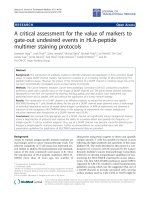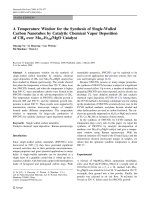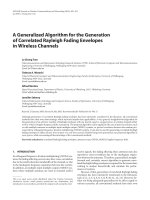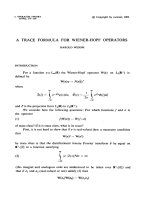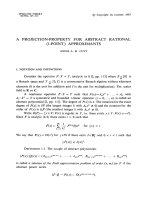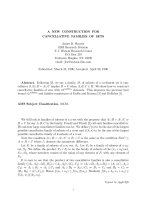Báo cáo toán học: "A sharp bound for the reconstruction of partitions" ppt
Bạn đang xem bản rút gọn của tài liệu. Xem và tải ngay bản đầy đủ của tài liệu tại đây (80.76 KB, 4 trang )
A sharp bound for the reconstruction of partitions
Vincent Vatter
Department of Mathematics
Dartmouth College
Hanover, NH 03755
Submitted: May 16, 2008; Accepted: Jun 22, 2008; Published: Jun 30, 2008
Mathematics Subject Classification: 05A17, 06A07
Abstract
Answering a question of Cameron, Pretzel and Siemons proved that every integer
partition of n ≥ 2(k + 3)(k + 1) can be reconstructed from its set of k-deletions. We
describe a new reconstruction algorithm that lowers this bound to n ≥ k
2
+ 2k and
present examples showing that this bound is best possible.
Analogues and variations of Ulam’s notorious graph reconstruction conjecture have
been studied for a variety of combinatorial objects, for instance words (see Sch¨utzenberger
and Simon [2, Theorem 6.2.16]), permutations (see Raykova [4] and Smith [5]), and com-
positions (see Vatter [6]), to name a few.
In answer to Cameron’s query [1] about the partition context, Pretzel and Siemons [3]
proved that every partition of n ≥ 2(k + 3)(k + 1) can be reconstructed from its set of
k-deletions. Herein we describe a new reconstruction algorithm that lowers this bound,
establishing the following result, which Negative Example 2 shows is best possible.
Theorem 1. Every partition of n ≥ k
2
+2k can be reconstructed from its set of k-deletions.
We begin with notation. Recall that a partition of n, λ = (λ
1
, . . . , λ
), is a finite
sequence of nonincreasing integers whose sum, which we denote |λ|, is n. The Ferrers
diagram of λ, which we often identify with λ, consists of left-justified rows where row
i contains λ
i
cells. An inner corner in this diagram is a cell whose removal leaves the
diagram of a partition, and we refer to all other cells as interior cells.
We write µ ≤ λ if µ
i
≤ λ
i
for all i; another way of stating this is that µ ≤ λ if and
only if µ is contained in λ (here identifying partitions with their diagrams). If µ ≤ λ, we
write λ/µ to denote the set of cells which lie in λ but not in µ. We say that the partition
µ is a k-deletion of the partition of λ if µ ≤ λ and |λ/µ| = k.
Recall that this order defines a lattice on the set of all finite partitions, known as
Young’s lattice, and so every pair of partitions has a unique join (or least upper bound)
µ ∨ λ = (max{µ
1
, λ
1
}, max{µ
2
, λ
2
}, . . . )
the electronic journal of combinatorics 15 (2008), #N23 1
and meet
µ ∧ λ = (min{µ
1
, λ
1
}, min{µ
2
, λ
2
}, . . . ).
Finally, recall that the conjugate of a partition λ is the partition λ
obtained by flipping
the diagram of λ across the NW-SE axis; it follows that λ
i
counts the number of entries
of λ which are at least i.
Before proving Theorem 1 we show that it is best possible:
Negative Example 2. For k ≥ 1, consider the two partitions
µ = (k + 1, . . . , k + 1
k
, k − 1) and
λ = (k + 1, . . . , k + 1
k−1
, k, k).
Note that no k-deletion of µ can contain the cell (k, k + 1) and that no k-deletion of λ
can contain the cell (k + 1, k). Therefore every k-deletion of µ and of λ is actually a
(k − 1)-deletion of
µ ∧ λ = (k + 1, . . . , k + 1
k−1
, k, k − 1),
so µ and λ cannot be differentiated by their sets of k-deletions.
We are now ready to prove our main result.
Proof of Theorem 1. Suppose that we are given a positive integer k and a set ∆ of k-
deletions of some (unknown) partition λ of n ≥ k
2
+ 2k. Our goal is to determine λ from
this information. We begin by setting µ =
δ∈∆
δ, noting that we must have λ ≥ µ.
Hence if |µ| = n then we have λ = µ and we are immediately done, so we will assume
that |µ| < n.
First consider the case where µ has less than k rows. Let r denote the bottommost
row of µ which contains at least k cells (r must exist because µ has less than k rows
and |µ| ≥ k
2
+ k). Thus the rth row of λ contains at least k cells as well, so there are
k-deletions of λ in which the removed cells all lie in or below row r. Hence the first r − 1
rows of λ and µ agree. Now note that λ has more than 2k cells to the right of column
k, so there are k-deletions of λ in which the removed cells all lie to the right of column
k, and thus the first k columns of λ and µ agree. This implies that λ and µ agree on all
rows below r (since these rows have less than k cells in µ) and so all cells of λ/µ must lie
in row r, uniquely determining λ, as desired. The case where µ has less than k columns
follows by symmetry.
We may now assume that µ has at least k rows and k columns. Let r (resp. c) denote
the bottommost row (resp. rightmost column) containing at least k cells. Both r and c
exist because µ has at least k rows and columns. Therefore both λ and µ can be divided
into three quadrants, 1, 2, and 3, as shown in Figure 1.
As before, we see that the first r − 1 rows and c − 1 columns of λ and µ agree. We
consider three cases based on whether and where r and c intersect.
the electronic journal of combinatorics 15 (2008), #N23 2
k
k
2 1
3
Figure 1: An example partition µ from Case 1 of the proof of Theorem 1, divided
into three quadrants. Here k = 8, and r and c appear shaded.
Case 1: r and c intersect at an interior cell of µ. Suppose that r and c intersect at the cell
(i, j). It follows from the maximality of r and c that i, j < k, and thus the cell (k, k) does
not lie in µ. Were the cell (k, k) to lie in λ then, because |λ| ≥ k
2
+ 2k, λ must contain
at least 2k cells to the right of or below (k, k) and thus λ would contain a k-deletion with
the cell (k, k), a contradiction; thus λ also does not contain (k, k).
Hence Quadrant 2 of λ contains less than k
2
cells, so λ must have more than k cells
in quadrant 1 or 3. Hence there are k-deletions of λ with more than k cells in quadrant
1 or 3; suppose by symmetry that λ and µ both have more than k cells in quadrant 1.
There are then k-deletions of λ in which the removed cells are all chosen from quadrant
1, so λ and µ agree on all cells in quadrants 2 and 3. This shows that r is also the
bottommost row of λ with at least k cells, and so λ/µ contains no cells below row r in
quadrant 1. As we already know that λ and µ agree on their first r − 1 rows, we can
therefore conclude that all cells of λ/µ lie in row r, which allows us to reconstruct λ and
complete the proof of this case.
Case 2: r and c intersect at an inner corner of µ. Then this inner corner must be the
rightmost cell of row r and the bottom cell of column c. It follows that r, c ≥ k. Because
λ and µ agree to the left of column c and above row r, all cells of λ/µ must lie below or
to the right of (r, c). However, the cell (r + 1, c + 1) cannot lie in λ because if it did then
one could form a k-deletion of λ by removing only points lying to the right of column c,
which would leave at least k cells in row r + 1 and contradict the definition of r. This
leaves only two possibilities for λ/µ: the cells (r, c + 1) and (r + 1, c). However, only one
of these cells can be added to µ to produce a partition; if both could be added then row
r + 1 and column c + 1 of λ would each contain at least k cells, implying the existence of
k-deletions of λ in which each contain at least k cells and thus contradicting the choice
of r and c. This case therefore reduces to checking which one of the cells (r, c + 1) and
(r + 1, c) can be added to µ to produce a partition.
the electronic journal of combinatorics 15 (2008), #N23 3
Case 3: r and c do not intersect. Suppose that the rightmost cell in row r is (r, j) and the
bottommost cell in column c is (i, c). If j < c − 1 then because λ and µ agree to the left
of column c, λ/µ cannot contain any cells in or below row r, and we already have that λ
and µ agree above row r, so we are left with the conclusion that λ = µ. By symmetry we
are also done if i < r − 1, leaving us to consider the case where i = r − 1 and j = c − 1.
Again using the fact that λ and µ agree above row r and to the left of column c (and the
definitions of r and c) we see that the only possibility for λ/µ is (r, c), completing the
proof of this case and the theorem.
Acknowledgements. I would like to thank the referee for several suggestions which
improved the transparency of the proof.
References
[1] Cameron, P. J. Stories from the age of reconstruction. Congr. Numer. 113 (1996),
31–41.
[2] Lothaire, M. Combinatorics on Words, vol. 17 of Encyclopedia of Mathematics and
its Applications. Addison-Wesley Publishing Co., Reading, Mass., 1983.
[3] Pretzel, O., and Siemons, J. Reconstruction of partitions. Electron. J. Combin.
11, 2 (2004–06), Note 5, 6 pp.
[4] Raykova, M. Permutation reconstruction from minors. Electron. J. Combin. 13
(2006), Research paper 66, 14 pp.
[5] Smith, R. Permutation reconstruction. Electron. J. Combin. 13 (2006), Note 11, 8
pp.
[6] Vatter, V. Reconstructing compositions. Discrete Math. 308, 9 (2008), 1524–1530.
the electronic journal of combinatorics 15 (2008), #N23 4

